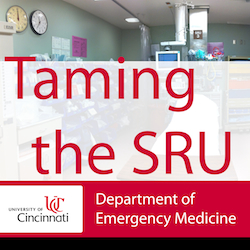Crew Resource Management
/We kick off the Air Care & Mobile Care Online Orientation with posts on some of the most important aspects of helicopter EMS - safety, survival and the basics of operating around the helicopter as a crew member. We’ll start off by talking about Crew Resource Management (CRM). In this first podcast, chief pilot Bob Francis, flight nurse Dennis Schmidt, and Dr. Ryan Gerecht sit down and talk about the basics of CRM and what it means to pilots and flight crew.
To give some perspective on the conversation here’s some background information on the genesis of CRM. Crew Resource Management is a series of safety principles originally developed after investigation into several airline accidents in the 1960’s and 70’s showed that human factors played a significant role in these accidents. It was originally termed “Cockpit Resource Management” and debuted in a NASA sponsored workshop in 1979. (Eisen & Savel, 2009)
The basic principles of CRM include:
- Maintaining team structure and climate
- Applying problem-solving strategies while maintaining situational awareness
- Communicating with the team
- Executing plans
- Managing workload
United Airlines flight 173: an example of a pre-CRM aircraft crash (NTSB, 1979)
On December 28, 1978, United Airlines flight 173 crashed 6 nmi southeast of the Portland International Airport in Portland, OR. Eight passengers and 2 crew members died and 21 passengers were seriously injured.
When lowering the landing gear for landing in Portland, the pilot and flight crew noticed a particularly loud thump, thump that was out of the ordinary, leading them to believe there was a problem with the landing gear. The flight crew focused heavily on trouble shooting this problem, and preparing the plane and passengers for a possible landing gear failure on landing for approximately an hour prior to approach. During this time, the plane became critically low on fuel, eventually running out of fuel, leading to the loss of engines, altitude and the crash. The NTSB determined that the “probable cause of the accident was the failure of the captain to monitor properly the aircraft’s fuel state and to properly respond to the low fuel state and the crewmember’s advisories regarding fuel state… His inattention resulted from preoccupation with a landing gear malfunction and preparations for a possible landing emergency.” It was also determined that the crewmember’s inability to either comprehend the critically low fuel state or successfully communicate the low fuel state to the captain contributed to the the accident.
US Airways flight 1549: an example of a post-CRM aircraft crash (NTSB, 2010)
On January 15, 2009, US Airways flight 1549 took off from LaGuardia Airport and shortly thereafter flew through a flock of birds. Birds striking the engines lead to a total loss of thrust and forced the air crew to ditch the aircraft into the Hudson River 8.5 mi from the airport. There were no fatalities and only 4 serious injuries (3 passengers and 1 flight attendant).
A time breakdown of this accident is truly fascinating
1527 - takeoff
1527:10 - The captain is heard on the cockpit voice recorder to say “Birds”
1527:13 - A decrease in engine power is heard on the cockpit voice recording
1527:23 - The pilot establishes his leadership in the situation by stating “My aircraft”
1527:28 - The pilot instructs the first officer “get the QRH (quick reference handbook) loss of thrust on both engines”
1527:33 - The pilot announces to the ground that there is an emergency by declaring “mayday, mayday, mayday..this is … Cactus 1539 hit birds, we’ve lost thrust in both engines, we’re turning back towards LaGuardia.”
1527:50 to 1530:01 - The pilot and the first officer work through the QRH step-by-step in an attempt to relight the engines. The communication through this process is closed-loop. It is clear. It is succinct.
1527:50 to 1529:27 - Simultaneously the pilot is communicating with departure control at LaGuardia and working through possible landing sites. The pilot declares they will be unable to return to LaGuardia. They attempt to head for Teterboro in New Jersey.
1529:27 - Departure control at LaGuardia asks which runway they will land at at Teterboro. The pilot recognizing they do not have the power to make it to Teterboro responds “we’re gonna be in the Hudson.”
1530:43 - The aircraft lands in the Hudson River and all passengers are evacuated.
A couple key themes emerge from comparing these two accidents:
First, good communication is absolutely imperative for creating a safe environment. Closed loop communication that is clear and succinct is a must. Communication also has to occur in all directions within a hierarchy. Being a good leader means being in control of the situation and listening to the advice/communication of those working with you. Good leaders however can’t succeed without good followers. To be a good follower is to be unafraid to speak up when something does seem right, to support the leader’s decision when they are correct, and to offer alternatives or ask for clarification when the leader’s decisions don’t seem correct.
Second, preparation and cognitive unloading with checklists can go a long way towards success in these. The checklist in the US Airways crash landing helped the crew approach the problem in a structured, proven way. While checklists aren’t the answer to all problems (they are not dynamic enough to address novel problems), they can help start you and the crew on the path towards fixing the problem.
- Eisen, L, & Savel, R. (2009) What Went Right: Lessons for the Intensivist from the Crew of US Airways Flight 1549. Chest. 136 (3), 910-917.
- NTSB. (1979) Aircraft Accident Report - United Airline, Inc, McDonnell-Douglas DC-8-61, N8082, Portland, Oregon, 12/28/1978.
- NTSB. (2010) Aircraft Accident Report: Loss of Thrust in Both Engines after Encountering a Flock of Birds and Subsequent Ditching in the Hudson River. US Airways flight 1549, Airbus A320-214, N106US, Weehawken, NJ, 1/15/2009





